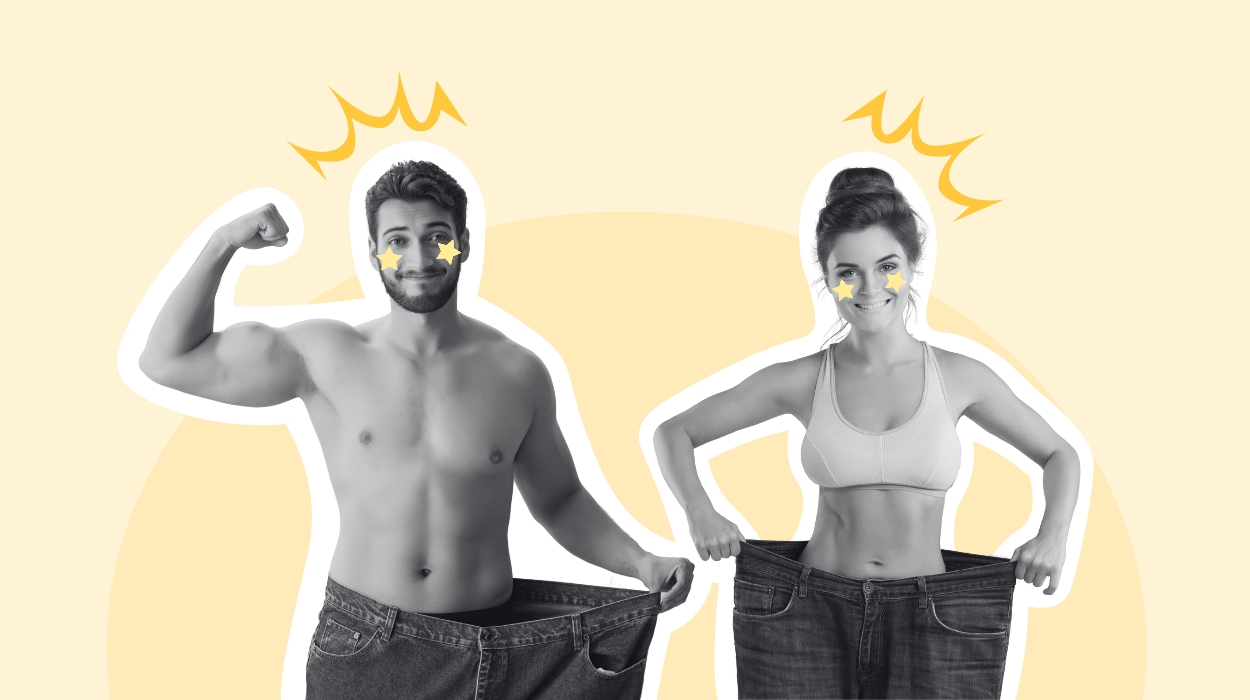Working towards achieving a lean and muscular physique doesn’t require an expensive gym membership or access to fancy equipment. You can get ripped right in the comfort of your own home. Working out at home offers numerous advantages and can be just as effective, if not more so, in reaching your fitness goals.
However, it takes more than a calorie deficit or regular workout–even at home. So, this article will guide you through how to get ripped at home by transforming your home into a workout haven. Discover some effective workout routines, how to fuel your body with proper nutrition, and take your home workout to the next level with advanced techniques.
Can You Get Ripped At Home?
Do you want that ripped six-pack abs and a lean, toned physique? Here are five best home workouts that will get you ripped:
- Upper body exercises.
- Lower body exercises.
- Abdominal and core exercises.
- Cardiovascular exercises.
- High-intensity interval training.
How To Get Ripped At Home?
Let’s face it: going to the gym is not always convenient. Finding the time to squeeze in a workout can be challenging between work and other obligations. But we still want to get ripped. So, can you get ripped at home?
The answer is yes. Some people might think that working out at home means limited workouts and thus results. But with the right attitude and a solid plan, you can achieve just as much as you would in a gym. You just need to know your way around the exercises.
For a full-body workout, You need to hit all the major muscle groups to get ripped from head to toe. Aim for well-rounded body weight exercises that include workouts for your upper body, lower body, and core. Your body will thank you for the balanced approach.
So here is a workout plan to get ripped at home to get ripped at home:
Upper Body Exercises
If you’re looking to get ripped at home, one of the most effective ways to target your upper body is through various exercises that focus on different muscle groups.
What object helps you to lose weight? For biceps and forearm strength, include curls using dumbbells or household objects like water bottles in your workout.
Push-Ups
Start with push-ups,[1] which work your chest and engage your triceps and shoulders. For an added challenge, try diamond push-ups, which target your triceps even more intensely
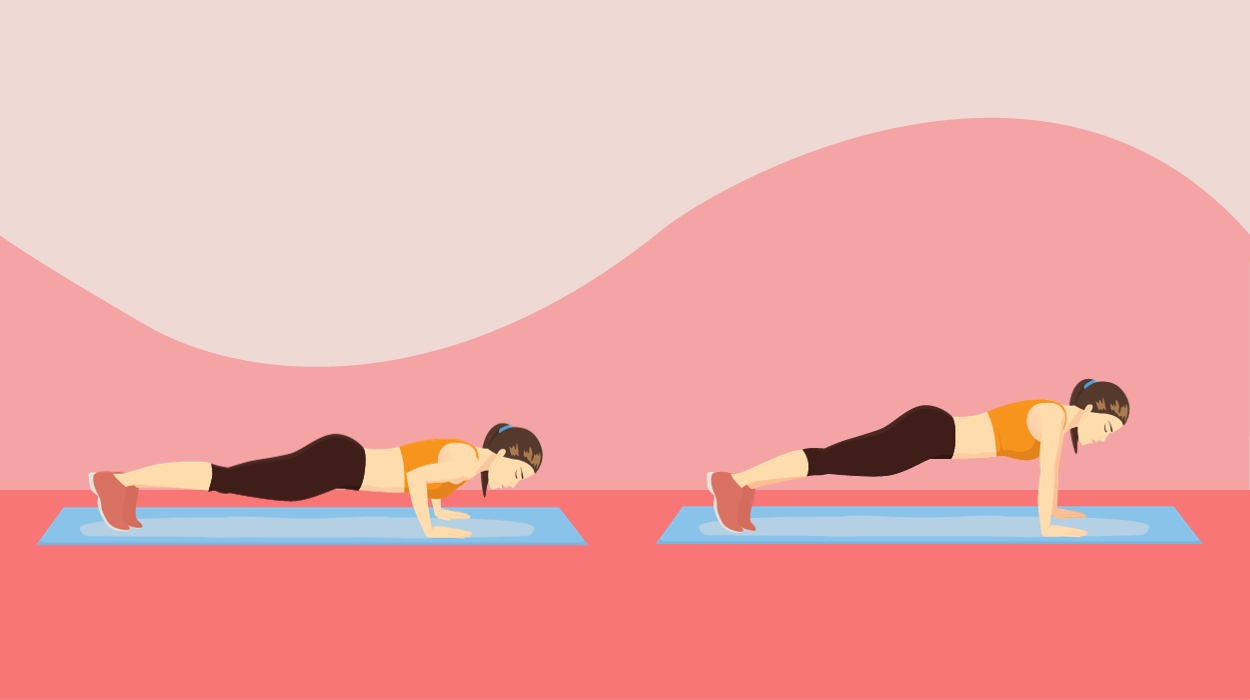
How to do:
- Start in a plank position with your hands slightly wider than shoulder-width apart in the standard push-up position.
- Slowly lower your body until your chest nearly touches the floor while keeping your core engaged and your back straight.
- Push through your palms to return to the starting position.
- For diamond push-ups, close your hands together directly under your chest, forming a diamond shape with your thumbs and index fingers.
Tips:
- Keep your body in a straight line from head to heels, engaging your core and glutes to avoid arching or sagging during push-ups.
- Place your hands slightly wider than shoulder-width apart to target the chest muscles effectively while maintaining proper form.
Optimal Sets and Reps: Start with three sets of eight to 10 push-ups, and gradually increase sets and reps.
Pull-Ups
Pull-ups are a challenging upper-body exercise that targets the back, shoulders, and arms. For strengthening and building muscles, incorporate pull-ups into your routine.
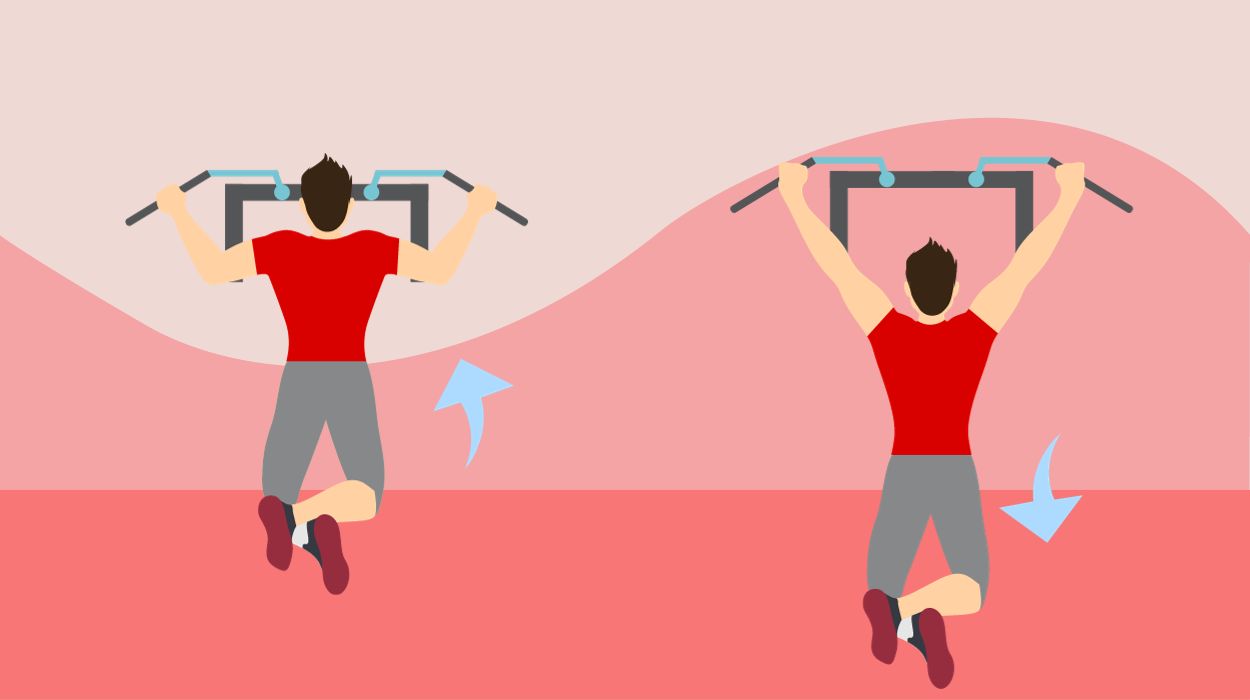
How to do:
- If you have a pull-up bar, grip the bar with your palms facing away from you, slightly wider than shoulder-width apart.
- Hang with your arms fully extended, then pull yourself up until your chin passes the bar. You have completed a single pull-up.
- Lower yourself back and repeat.
Tips:
- Use an overhand grip with your hands slightly wider than shoulder-width apart to target the back muscles effectively.
- Keep your core engaged and avoid swinging or using momentum to pull yourself up. Focus on controlled, full-range-of-motion repetitions.
Optimal Sets and Reps: Start with three sets of five to eight pull-ups, gradually increasing both sets and reps as you build strength.
Remember to maintain proper form throughout each exercise, control your movements, and focus on engaging the targeted muscle groups. Gradually increase the number of repetitions or sets as you progress to continue challenging yourself, promoting muscle growth, and losing subcutaneous fat.
Lower Body Exercises
Following upper body exercises, you also want to lose fat in your legs and glutes. Lower body exercises are your key to success. It’s commonly called leg day.
Squats
Start with a classic: squats. The exercise targets and builds multiple muscles[2] in your lower body — quads, hamstrings, and glutes. Try variations like jump squats or pistol squats to make it more challenging.

How to do:
- Stand with your feet shoulder-width apart or slightly wider in a lunge position, toes pointing slightly outward.
- Engage your core, keep your chest up, and lower your body by bending your knees and hips as if sitting back in an imaginary chair.
- Aim to leave your leg slightly bent until your thighs are at least parallel to the floor, ensuring your knees don’t extend beyond your toes.
- Push through your heels to return to the starting standing position.
Tips:
- Keep your feet shoulder-width apart, chest up, and back straight while descending into the squat to protect your knees and lower back.
- Lower your body until your thighs are parallel to the ground or as far as flexibility allows, ensuring you engage your glutes and quads effectively.
Optimal Sets and Reps: Begin with three sets of eight to 12 reps with proper form.
Lunges
Next up, lunges, Whether forward or reverse lunges, they work wonders for strengthening your quadriceps and enhancing stability. Calf raises are also the go-to exercise here — simply stand on a ledge or step with just your toes on the edge and raise using your calves.
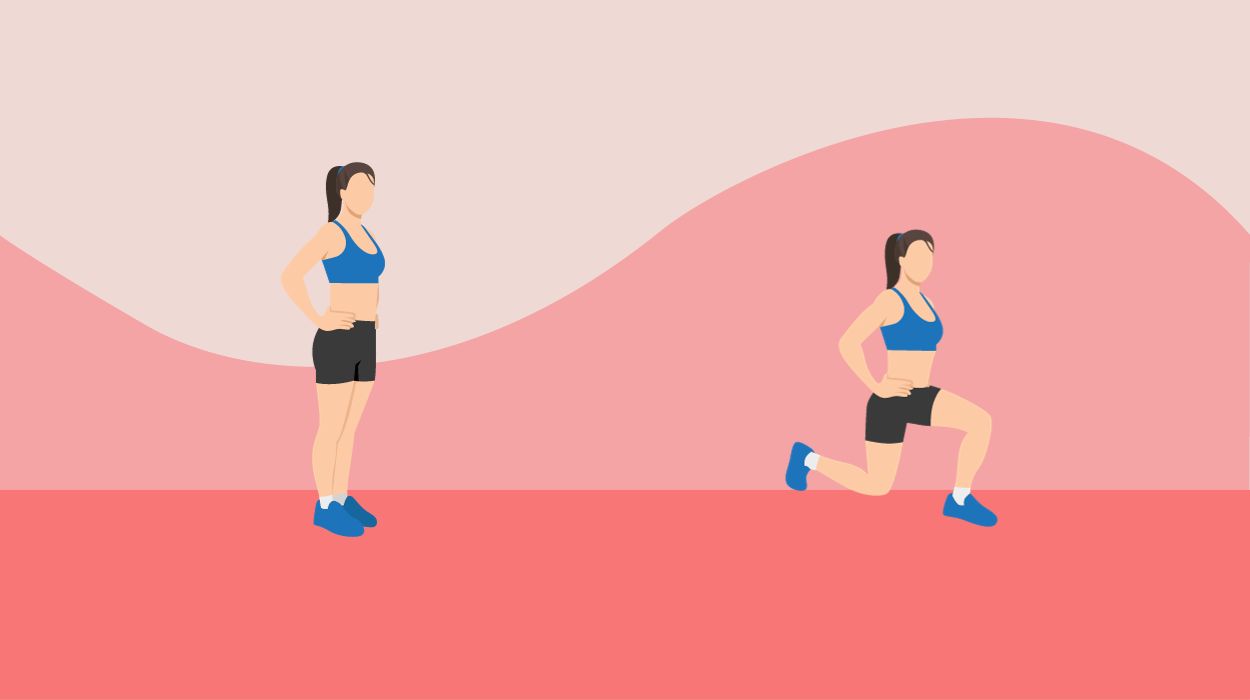
How to do:
- Start standing tall with your feet hip-width apart.
- Take a step forward or backward with your left leg and lower your hips until both knees are bent at a 90-degree angle.
- The front knee should not extend beyond your toes, and the back knee should hover above the ground.
- Push back up to the starting position using your front heel.
- Repeat on both legs.
Tips:
- Step forward with one leg, ensuring your knee is directly above your ankle and your back knee hovers just above the ground.
- Maintain an upright posture throughout the lunge, engaging your core for stability.
- Perform lunges with a slow, controlled motion to engage your leg muscles effectively and reduce the risk of injury.
Optimal Sets and Reps: Three to four sets of lunges with 10-15 reps per set on each leg.
Abdominal And Core Exercises
Your go-to shredded workout should be core exercises.[3] A strong core looks impressive and gives you a toned muscular body. Start with basic exercises like planks, which engage multiple core muscles simultaneously.
Then, gradually progress to more challenging variations such as side planks or Russian twists. Another great exercise is the bicycle crunch, which targets both upper and lower abdominals while also working oblique muscles.
Planks
Planks are a highly effective core-strengthening exercise that involves holding a push-up-like position with your arms straight and your body in a straight line from head to heels.
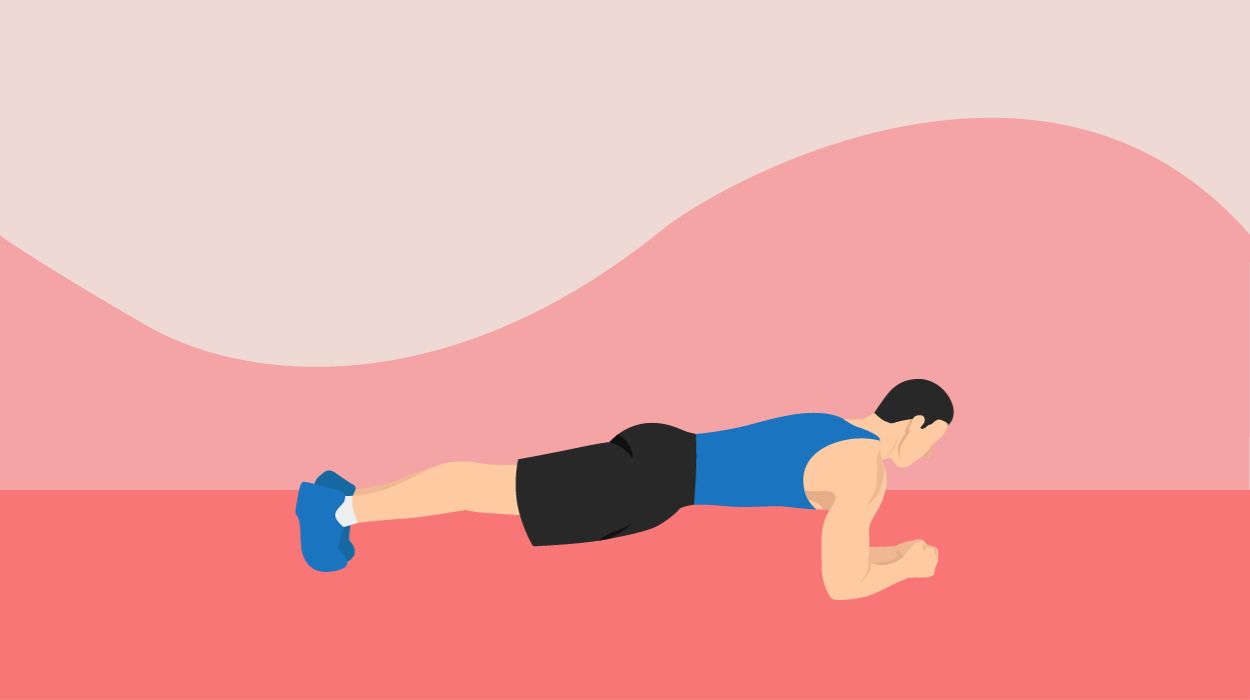
How to do:
- Begin in a push-up position, resting on your forearms instead of your hands.
- Keep your body straight from head to heels, engaging your core muscles to maintain stability.
- Hold this position for a set amount of time, starting with 20-30 seconds and gradually increasing as you get stronger.
Tips:
- Keep your body in a straight line from head to heels, engaging your core muscles and avoiding arching or sagging.
- Remember to breathe steadily and avoid holding your breath while holding the plank position to enhance endurance.
- If you’re a beginner, begin with shorter holds (20-30 seconds) and gradually increase the duration as you get stronger.
Optimal Sets and Reps: Hold a plank for 20-60 seconds per set, and perform two to four sets with brief rests in between.
Russian Twists
Russian Twists, a dynamic core exercise, involve sitting with knees bent and feet raised while twisting your torso from side to side, often holding a weight or medicine ball. This movement targets the obliques and improves core stability and rotational strength.
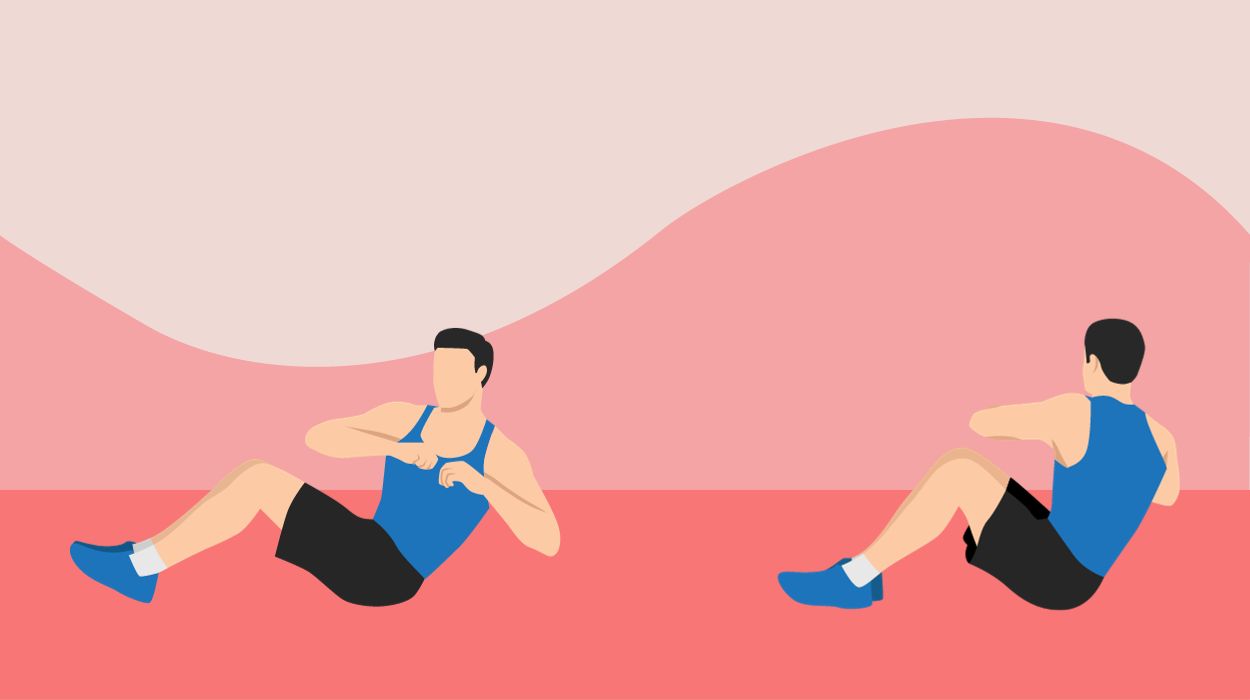
How to do:
- Sit on the floor with your knees bent and heels on the ground, and lean back slightly while keeping your back straight.
- Hold a weight, medicine ball, or hands clasped together.
- Do torso rotations by twisting your torso to one side, bringing the object or hands close to the floor beside your hip.
- Return to the center and then twist to the other side, alternating in a controlled manner.
Tips:
- Keep your core muscles tight throughout the exercise to stabilize your spine and protect your lower back.
- Sit up tall, with your back straight, and focus on rotating your torso from your waist, not just moving your arms.
- Twist slowly and with control to maximize the engagement of your obliques and prevent straining your back.
Optimal Sets and Reps: Three to four sets with 10-15 reps per set on each side.
Bicycle Crunches
Bicycle crunches are a dynamic core exercise that engages multiple core muscles and enhances both strength and flexibility.
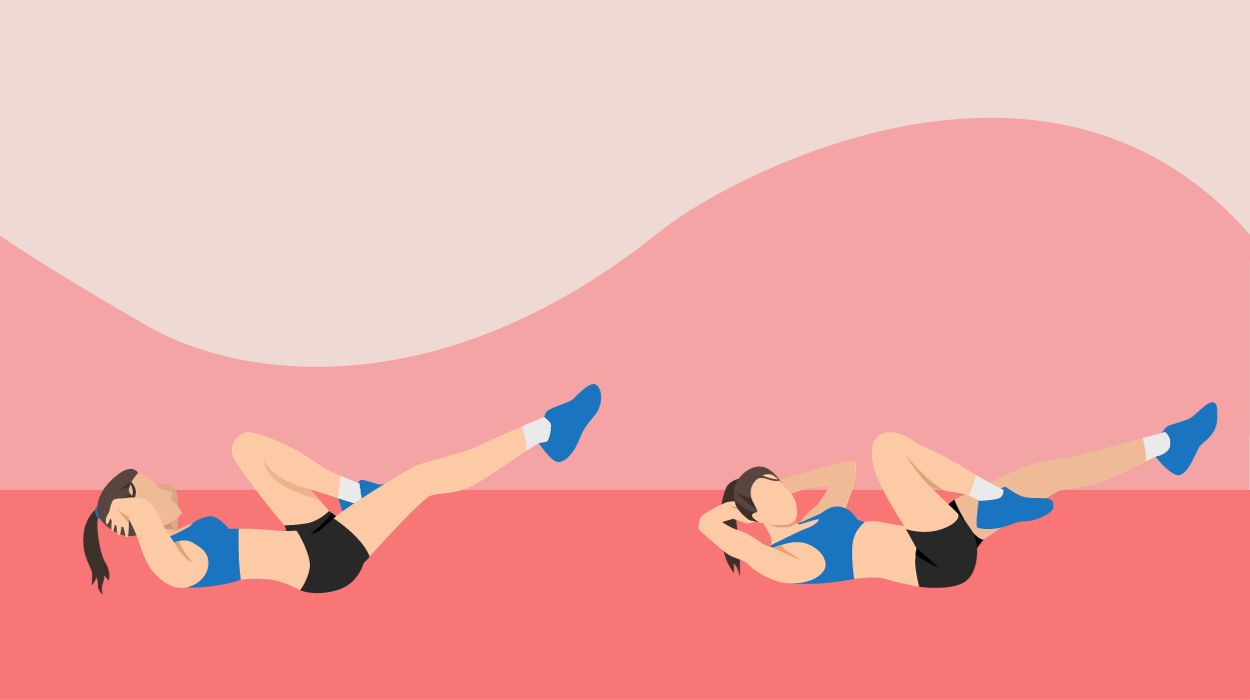
How to do:
- Lie flat on your back with your hands behind your head, elbows pointing out.
- Lift your shoulders off the ground and bring one knee toward your chest while simultaneously twisting your torso, bringing the opposite elbow towards the knee.
- Straighten the bent leg while bringing the other knee towards your chest and twisting to bring the opposite elbow towards it.
- Continue this pedaling motion, alternating sides in a controlled manner.
Tips:
- Perform each bicycle crunch with a slow and controlled motion, emphasizing the twisting motion to work your obliques effectively.
- Keep your core muscles actively engaged throughout the exercise to maintain stability and maximize the effectiveness of the movement.
- Exhale as you bring your elbow to the opposite knee and inhale as you switch sides, maintaining a steady breathing pattern to support the exercise.
Optimal Sets and Reps: Three to four sets with 15-20 reps per set.
Cardiovascular Exercises
When it comes to getting ripped, it’s not just about building muscles. Cardiovascular exercises[4] play a crucial role in your fitness journey. If you’re looking to lose weight and build endurance, cardio is the way to go.
You can do it all from the comfort of your living room. Think jumping jacks, mountain climbers, and high knees. Cardio exercises help you burn fat and improve your overall endurance and stamina. So, aim for at least 30 minutes of cardio every day and gradually increase your intensity as time goes on.

How to do:
- Choose an activity (running, cycling, swimming).
- Warm up for 5-10 minutes.
- Maintain a steady pace.
- Cool down and stretch.
- Stay hydrated throughout.
Tips:
- Aim for regular cardiovascular workouts to improve cardiovascular fitness, aiming for at least 150 minutes per week.
- Incorporate a mix of cardio activities to prevent boredom and work different muscle groups.
- Drink water before, during, and after your workout to maintain optimal performance and prevent dehydration.
Optimal Sets and Reps: Strive for 150 minutes of moderate or 75 minutes of vigorous cardio weekly, in 20-30 minute sessions on most days.
High-Intensity Interval Training
One of the best ways to see results from your workouts is to try high-intensity interval training. HIIT is a fitness technique[5] that involves short bursts of intense exercise followed by brief recovery periods.
This approach torches calories and promotes muscle growth and increased metabolism. To kickstart your at-home rip-fest, choose exercises from above that target multiple muscle groups, such as cardio or squat jumps.
Start with a warm-up to prepare your body, then dive into 20-second bursts of all-out effort interspersed with 10 to 15 seconds of rest. Aim for about ten rounds, gradually increasing the number as you build endurance. Remember, form is key here, so maintain proper posture and engage those muscles fully.

How to do:
- Warm up for 5-10 minutes.
- Choose intense exercises.
- Alternate high-intensity bursts with brief rests.
- Repeat 3-4 sets.
- Cool down and stretch.
Tips:
- Prioritize proper form and safety during high-intensity intervals to prevent injuries. Maintain control, especially during explosive movements.
- Tailor HIIT to your fitness level by adjusting work-to-rest ratios and exercise selection. Start with a 1:2 ratio (e.g., 20 seconds high-intensity, 40 seconds rest) and progress as you improve.
- Pay attention to signs of fatigue or overexertion. Modify or take extra rest as needed to avoid pushing too hard.
Optimal Sets and Reps: Aim for three to four sets of four to six high-intensity intervals, with each interval lasting 20-30 seconds, followed by 40-60 seconds of rest or low-intensity activity.
Can You Get Ripped Without A Gym?
Yes, getting ripped without a gym is possible. While going to the gym can provide access to a wide range of equipment and professional trainers, it is not the only way to achieve a sculpted physique.
Adopting a home workout routine combining bodyweight exercises with cardio activities like running or cycling can effectively build muscle and burn fat.
Push-ups, squats, lunges, and planks are a few examples of body-building exercises that simultaneously target multiple muscle groups. Investing in basic workout equipment like resistance bands or dumbbells can provide extra resistance for more advanced movements.
More Tips On How To Get Ripped Fast
Aside from exercise, many other lifestyle modifications can help you get ripped at home quickly without going to fitness centers. Here are some more tips:
Nutrition
Getting ripped is not just exercise; a healthy diet plan and a caloric deficit play a crucial role[6] in building muscle. For one, you need to consume fewer calories than you usually do. This calorie deficit is key to burning unwanted fat.
Then, you need to increase your protein intake[7] enough to build muscle. A high-protein diet means that protein should be at least 30-35% of your calorie intake. Generally, a good range of protein intake[8] is 1.2-1.5g/kg.
Protein-rich foods such as lean meats are essential for muscle recovery and growth. There are many ways to improve your protein intake. You can try a protein supplement or shakes that are proven to help with bodybuilding.[9]
And don’t forget your carbs.[10] They give you the energy to power through those intense workout sessions and help replenish glycogen stores in your muscles afterward. They include complex carbs like brown rice, sweet potatoes, and oats.
Healthy fats shouldn’t be shunned, either. Avocados, nuts, and olive oil are some options you should include. Lastly, supplement your diet with fruits and vegetables for a well-rounded nutrition plan.
You can also try diet pills to facilitate stubborn weight loss. In addition, many fat burners for men help with losing fat.
Hydration
Often underestimated, staying adequately hydrated is vital for muscle function and overall performance. Water helps transport nutrients, regulate body temperature, and support muscle recovery[11] after exercise.
Aim to drink at least 6-8 glasses of water[12] daily and more in heat and with sweating from exercise. Also, hydration doesn’t just come from water; fruits, vegetables, and herbal teas contribute too.
Rest And Recovery
Muscles need time to repair and grow after workouts. Prioritize quality sleep as it’s essential for muscle recovery and overall well-being. Aim for 7-9 hours of uninterrupted sleep[13] per night. Additionally, incorporate rest days into your workout routine to prevent burnout and allow your muscles to recover fully.
Consistency
Consistency in both workouts and nutrition is key. Stick to a well-designed workout routine and nutrition plan consistently. Remember, achieving a ripped physique takes time and dedication.
It’s a combination of proper nutrition, adequate rest, hydration, stress management, and consistent workouts that ultimately yields results. Tailor these aspects to suit your body and lifestyle for sustainable progress.
Final Thoughts
Achieving a ripped physique from the comfort of your home is not just a possibility but a reality for those committed to their fitness goals. Remember, this journey towards a chiseled physique isn’t an overnight process. It requires dedication, consistency, and patience. Every step you take, every workout completed, and every nutritious meal consumed contributes to your progress.
Celebrate the small victories and stay committed to the bigger goal.
Frequently Asked Questions
Yes, achieving a ripped physique at home through targeted workouts, proper nutrition, and consistent dedication to fitness routines is possible.
Bodyweight exercises like push-ups, squats, lunges, and planks are excellent for building muscle without using weights.
The time it takes to get ripped at home varies for individuals based on factors like starting fitness level, dedication, and consistency but expect several months to a year for noticeable results.
 Expert's opinion
Expert's opinion
